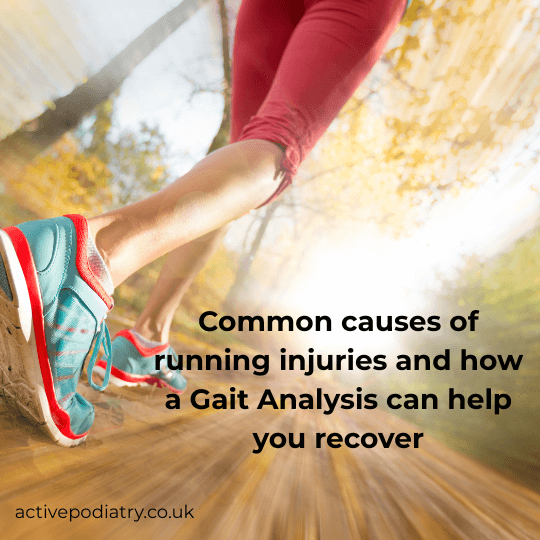Common Causes of Running Injuries and How Gait Analysis Can Help You Recover

Common Causes of Running Injuries and How Gait Analysis Can Help You Recover
Introduction
Running injuries are rarely random — there is almost always an underlying cause, often more than one. In my running injury clinics, I regularly see patterns and contributing factors that affect runners of all abilities. In this article I will share the most common causes of running injuries and explain how a professional gait analysis can help you recover and reduce your risk of future problems.
- Overuse and Training Load Errors
One of the most common causes of running injuries is overtraining — doing too much too soon. This typically happens when running volume or intensity increases too quickly, without allowing adequate rest and recovery. Without a structured training plan, your muscles, tendons, and joints may not have enough time to adapt, leading to inflammation, microtears, and eventually injury.
Tip: Following a gradual progression plan and listening to early warning signs, such as persistent soreness or fatigue, can significantly lower your risk.
- Running Biomechanics
Your running biomechanics — the way you move — determine how forces are distributed through your body with every step. While there is no single “perfect” running form, asymmetrical or excessive loading on certain tissues can lead to problems over time.
Small changes to running form, such as improving posture, cadence, or stride mechanics, can often improve performance and reduce injury risk.
- Footwear Choices
The “best” running shoe is not always the most expensive or heavily marketed. In fact, research shows that comfort is one of the most reliable indicators when selecting footwear.
Different shoes can change how forces are loaded through the foot, ankle, and lower limb, which means the right shoe for one runner may not work for another. The key is to choose footwear that matches your foot type, running biomechanics, and training demands.
- Additional Contributing Factors
Beyond training load, biomechanics, and footwear, other factors can contribute to running injuries, including:
- Muscle imbalances or weakness
- Limited flexibility in key joints
- Poor sleep or high stress levels
- Inadequate nutrition or hydration
- Previous injuries that have not been fully rehabilitated
Understanding how these factors interact is essential to preventing injuries from becoming recurrent or chronic.
How a Gait Analysis Can Help You Recover
A running gait analysis is much more than simply watching you run. At our clinics, we carry out a detailed assessment that includes:
- Reviewing your current training plan (if you have one)
- Taking a full medical and injury history
- Considering lifestyle influences such as stress and sleep quality
- Measuring strength, flexibility, and balance
- Analysing your movement patterns both walking and running
By combining this information, we can create a personalised rehabilitation programme to address the root causes of your injury. This approach not only helps you recover faster but also reduces the likelihood of the same injury happening again.
Conclusion
Running injuries have multiple causes, but with the right assessment and targeted rehabilitation, recovery is achievable. By addressing training errors, biomechanics, footwear, and lifestyle factors, we can help you get back to running with confidence.
If you are dealing with a running injury or want to prevent one from happening, a professional gait analysis can be the first step towards a stronger, pain-free future.

 Active Podiatry - Podiatry in Kent for Runners & Active People
Active Podiatry - Podiatry in Kent for Runners & Active People